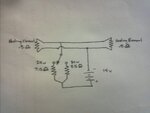mromrell
Newbie level 3
I'm new to this Forum but my friends tell me that you guys are awesome!
So here's the deal: I am building electric hand heaters for my motorcycle and I need some verification that I'm doing this properly. My bike puts out 14 volts and 700 watts total. I want to run these heaters at 30 watts. (below is my basic schematic.)

My calculations tell me that I need a 5.5 ohm resistor for the 30 watt
Would that resistor need to be rated at 700 W? or 30 W?
If it needs to be rated at 700 W, then how would I lower the wattage to that circuit so that it operated at 30 W?
My other assumptions are:
30w/14Volts = 2.14 Amps
14volts/2.14 Amps = 6.53 Ω needed throughout the circuit.
since 10 ft of 30 gauge heating wire amounts to 1.03 Ω then
6.53 Ω - 1.03 Ω = 5.5 Ω Resistor that needs to be added to the circuit.
Does that look like it would work?
:-o Thank you for your help!!!! :smile:
So here's the deal: I am building electric hand heaters for my motorcycle and I need some verification that I'm doing this properly. My bike puts out 14 volts and 700 watts total. I want to run these heaters at 30 watts. (below is my basic schematic.)

My calculations tell me that I need a 5.5 ohm resistor for the 30 watt
Would that resistor need to be rated at 700 W? or 30 W?
If it needs to be rated at 700 W, then how would I lower the wattage to that circuit so that it operated at 30 W?
My other assumptions are:
30w/14Volts = 2.14 Amps
14volts/2.14 Amps = 6.53 Ω needed throughout the circuit.
since 10 ft of 30 gauge heating wire amounts to 1.03 Ω then
6.53 Ω - 1.03 Ω = 5.5 Ω Resistor that needs to be added to the circuit.
Does that look like it would work?
:-o Thank you for your help!!!! :smile: